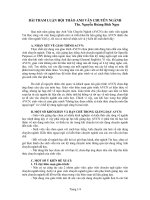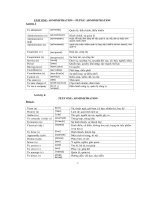anh văn chuyên ngành 4
Bạn đang xem bản rút gọn của tài liệu. Xem và tải ngay bản đầy đủ của tài liệu tại đây (2.52 MB, 22 trang )
ENGLISH FOR AUTOMOBILE
INDUSTRY
UNIT 3: The engine
MASTER VO ANH TUAN
Four-Stroke Cycle
Automobile engines normally use a fourstroke cycle. Four separate piston
strokes (up or down move ments) are
needed to produce one cycle (complete
series of events). The piston must slide
down, up, down, and up again to
complete one cycle.
1. The intake stroke draws the air-fuel
mixture into the engine’s combustion
chamber. The piston slides down while
the intake valve is open and the exhaust
valve is closed. This pro duces a vacuum
(low-pressure area) in the cylinder.
Atmospheric
pressure
(outside
air
pressure) can then force air and fuel into
the combustion chamber.
Four-Stroke Cycle
2.
The
compression
stroke
prepares the air-fuel mixture for
combustion. With both valves closed,
the piston slides upward and
compresses (squeezes) the trapped
air-fuel mixture.
Four-Stroke Cycle
3. The power stroke produces
the energy to operate the engine.
With both valves still closed, the
spark plug arcs (sparks) and
ignites the com pressed air-fuel
mixture. The burning fuel expands
and develops pressure in the
combustion chamber and on the
top of the piston. This pushes the
piston down with enough force to
keep the crankshaft spinning until
the next power stroke.
Four-Stroke Cycle
4. The exhaust stroke removes the
burned gases from the combustion
chamber. During this stroke, the
piston slides up while the exhaust
valve is open and the intake valve is
closed. The burned fuel mixture is
pushed out of the engine and into
the exhaust system.
During engine operation, these four
strokes are repeated over and over.
With the help of the heavy fly wheel,
this action produces smooth,
rotating power output at the engine
crankshaft.
Basic Engine Parts
The basic parts of a simplified one-cylinder
engine are shown in figure. Refer to this
illustration as each part is introduced.
The
block is metal casting that holds all
the other engine parts in place.
The
cylinder is a round hole bored
(machined) in the block. It guides piston
movement.
The
piston is a cylindrical component
that transfers the energy of combustion
(burning of air-fuel mixture) to the
connecting rod.
Basic Engine Parts
The
rings seal the small gap around the sides of the piston. They
keep combustion pressure and oil from leaking between the piston
and the cylinder wall (cylinder surface).
The
connecting rod links the piston to the crankshaft.
The
crankshaft changes the reciprocating (up and down) motion of
the piston and rod into useful rotary (spinning) motion.
The
cylinder head covers and seals the top of the cylinder. It also
holds the valves, rocker arms, and often, the camshaft.
The
combustion chamber is a small cavity (hollow area) between
the top of the piston and the bottom of the cylinder head. The burning
of the air-fuel mixture occurs in the combustion chamber.
Basic Engine Parts
The
valves open and close to control the flow of the air-fuel mixture
into the combustion chamber and the exhaust gases out of the
combustion chamber.
The
camshaft controls the opening of the valves.
The
valve springs keep the valves closed when they do not need to
be open.
The
rocker arms transfer camshaft action to the valves.
The
lifters, or followers, ride on the camshaft and transfer motion to
the other parts of the valve train.
The
flywheel helps keep the crankshaft turning smoothly. It also
provides a large gear for the starting motor.
An engine block for a V8 engine
Cylinder Head
The cylinder head fits on top of the
cylinder block to close off and seal the top
of the cylinders.
The combustion chamber is an area into
which the air-fuel mixture is compressed
and burned. The cylinder head contains all
or most of the combustion chamber. The
cylinder head also contains ports, which
are passageways through which the air-fuel
mixture enters and burned gases exit the
cylinder. A cylinder head can be made of
cast iron or aluminum.
Cylinder Block
The biggest part of the engine is the
cylinder block, which is also called an
engine block.
The cylinder block is a large casting of
metal (cast iron or aluminum) that is drilled
with holes to allow for the passage of
lubricants and coolant through the block
and provide spaces for movement of
mechanical parts. The block contains the
cylinders, which are round passageways
fitted with pistons. The block houses or
holds the major mechanical parts of the
engine.
Piston
Piston
The
burning of air and fuel takes place between the cylinder head and the
top of the piston. The piston is a can-shaped part closely fitted inside the
cylinder. In a four-stroke cycle engine, the piston moves through four
different movements or strokes to complete one cycle. These four are the
intake, compression, power, and exhaust strokes. On the intake stroke, the
piston moves downward, and a charge of air-fuel mixture is introduced into
the cylinder. As the piston travels upward, the air-fuel mixture is
compressed in preparation for burning. Just before the piston reaches the
top of the cylinder, ignition occurs and combustion starts. The pressure of
expanding gases forces the piston downward on its power stroke. When it
reciprocates, or moves upward again, the piston is on the exhaust stroke.
During the exhaust stroke, the piston pushes the burned gases out of the
cylinder.
Connecting Rods and Crankshaft
The reciprocating motion of the pistons
must be converted to rotary motion
before it can drive the wheels of a
vehicle. This conversion is achieved by
linking the piston to a crankshaft with a
connecting rod. As the piston is
pushed down on the power stroke, the
connecting rod pushes on the
crankshaft, causing it to rotate. The end
of the crankshaft is connected to the
transmission to continue the power flow
through the drivetrain and to the wheels.
Manifolds
A manifold is metal ductwork
assembly used to direct the flow of
gases to or from the combustion
chambers. Two separate manifolds
are attached to the cylinder head.
The intake manifold delivers a
mixture of air and fuel to the intake
ports. The exhaust manifold
mounts over the exhaust ports and
carries exhaust gases away from the
cylinders.









